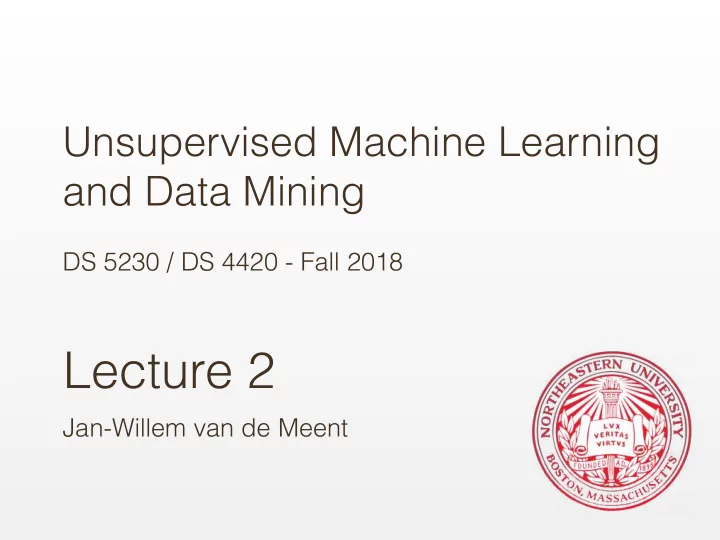

Unsupervised Machine Learning and Data Mining DS 5230 / DS 4420 - Fall 2018 Lecture 2 Jan-Willem van de Meent
Probability
Examples: Independent Events 1. What’s the probability of getting a sequence of 1,2,3,4,5,6 if we roll a dice six times? 2. A school survey found that 9 out of 10 students like pizza. If three students are chosen at random with replacement, what is the probability that all three students like pizza?
Dependent Events uit Apple or- intro- Orange Red bin Blue bin If I randomly pick a fruit from the red bin, what is the probability that I get an apple ?
Dependent Events uit Apple or- intro- Orange Red bin Blue bin Conditional Probability P(fruit = apple | bin = red ) = 2 / 8
Dependent Events uit Apple or- intro- Orange Red bin Blue bin Joint Probability P(fruit = apple , bin = red ) = 2 / 12
Dependent Events uit Apple or- intro- Orange Red bin Blue bin Joint Probability P(fruit = apple , bin = blue ) = ?
Dependent Events uit Apple or- intro- Orange Red bin Blue bin Joint Probability P(fruit = apple , bin = blue ) = 3 / 12
Dependent Events uit Apple or- intro- Orange Red bin Blue bin Joint Probability P(fruit = orange , bin = blue ) = ?
Dependent Events uit Apple or- intro- Orange Red bin Blue bin Joint Probability P(fruit = orange , bin = blue ) = 1 / 12
Two rules of Probability uit or- intro- 1. Sum Rule (Marginal Probabilities) P(fruit = apple ) = P(fruit = apple , bin = blue ) + P(fruit = apple , bin = red ) = ?
Two rules of Probability uit or- intro- 1. Sum Rule (Marginal Probabilities) P(fruit = apple ) = P(fruit = apple , bin = blue ) + P(fruit = apple , bin = red ) = 3 / 12 + 2 / 12 = 5 / 12
Two rules of Probability uit or- intro- 2. Product Rule P(fruit = apple , bin = red ) = P(fruit = apple | bin = red ) p(bin = red ) = ?
Two rules of Probability uit or- intro- 2. Product Rule P(fruit = apple , bin = red ) = P(fruit = apple | bin = red ) p(bin = red ) = 2 / 8 * 8 / 12 = 2 / 12
Two rules of Probability uit or- intro- 2. Product Rule (reversed) P(fruit = apple , bin = red ) = P(bin = red | fruit = apple ) p(fruit = apple ) = ?
Two rules of Probability uit or- intro- 2. Product Rule (reversed) P(fruit = apple , bin = red ) = P(bin = red | fruit = apple ) p(fruit = apple ) = 2 / 5 * 5 / 12 = 2 / 12
Bayes' Rule Posterior Likelihood Prior Sum Rule: Product Rule:
Bayes' Rule Posterior Likelihood Prior Probability of rare disease: 0.005 Probability of detection: 0.98 Probability of false positive: 0.05 Probability of disease when test positive?
Bayes' Rule Posterior Likelihood Prior 0.98 * 0.005 = 0.0049 0.98 * 0.005 + 0.05 * 0.995 = 0.0547 0.0049 / 0.0547 = 0.089
Random Variables • Random Variable: A variable with a stochastic outcome X = x x ∈ {1, 2, 3, 4, 5, 6} • Event: A set of outcomes X >= 3 {3, 4, 5, 6} • Probability: The chance that a randomly selected outcome is part of an event P ( X >= 3 ) = 4 / 6
Distribution • A distribution maps outcomes to probabilities P ( X = x ) = 1 / 6 • Commonly used (or abused) shorthand: P ( x ) is equivalent to P ( X = x )
Recommend
More recommend